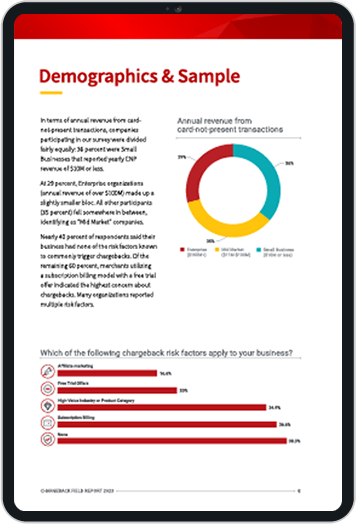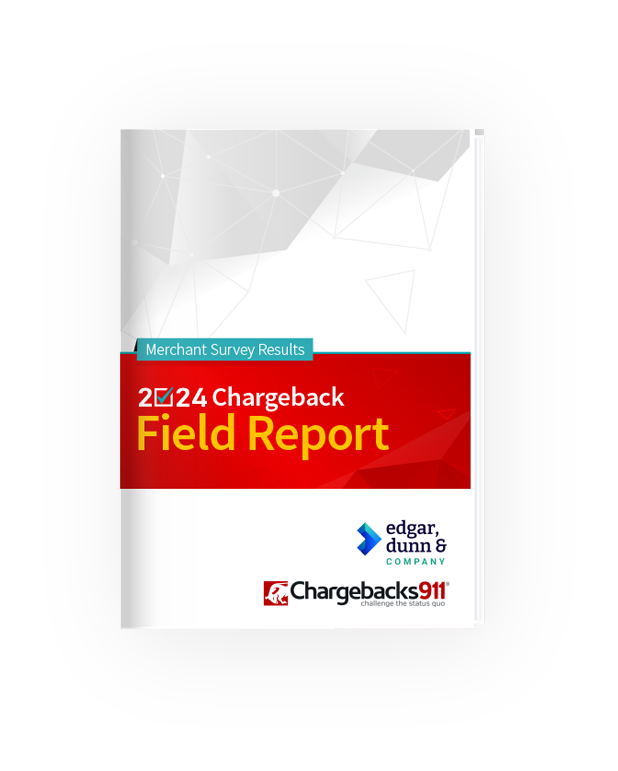Fake Google Reviews: More Common Than You Think
Here’s the unfortunate truth: fake Google reviews, as damaging as they can be to your business, are far more common than you might like to believe.
Google took down 170 million policy-violating reviews in 2023. The internet giant also removed 12 million fake business profiles and thwarted 2 million attempts to hijack legitimate ones.
Unfortunately, they won’t be able to catch every single fake review. And, the spam, scams, and account takeover (ATO) attacks that precipitate those fake Google reviews hurt everyone, including searchers, customers and, most of all, merchants.
Recommended reading
- Fraud as a Service: How it Works | Examples | Detection
- The Top 10 Prepaid Card Scams to Watch Out For in 2025
- How do Banks Conduct Credit Card Fraud Investigations?
- What is Third-Party Fraud? Tactics, Red Flags & Prevention
- How New Account Fraud Works: Red Flags & How to Prevent it
- Review Fraud: How it Works & How to Get Rid of Fake Reviews
Why Fake Reviews Occur
Some businesses use fake reviews to boost their profile and attract customers. But, some parties will use fake reviews to tarnish a business’s reputation and try to sabotage them.
Not all fake Google reviews are negative; some express positive sentiment.
Positive fake reviews can happen when businesses use “black-hat” techniques to manipulate local search engine rankings, to instill false confidence in their goods or services, or illicitly bolster their reputations. Merchants may also entice customers to leave positive reviews in exchange for discounts or gifts.
Soliciting reviews is not against Google’s terms of service. But, explicitly requiring buyers to leave positive reviews in exchange for incentives is a violation of search engine policies.
Meanwhile, “bad” fake reviews can occur when competitors attempt to sabotage rivals, or when disgruntled customers or members of the public create multiple accounts to poorly review targeted businesses en-masse.
Both positive and negative fake Google reviews are becoming more common. A Search Engine Land investigation revealed that, between 2022 and 2023, the volume of policy-violating reviews on Google rose by 45%. That’s because widely accessible tools like generative AI and automated account creation scripts are making fake-but-believable reviews more prevalent, and more difficult to detect at the same time.
Impact of Fake Reviews on Businesses
Fake Google reviews have a substantial impact on businesses. In response, the FTC has imposed penalties for posting fake reviews.
Fake reviews are harmful, no matter the sentiment expressed. They mislead customers, unfairly damage or enrich a business’ reputation in the marketplace, and run contrary to the principles of good faith and fair dealing.
Fake reviews can also make customers less likely to buy from you, which could cause you to lose out on revenue and profits. If an excessive number of fake reviews are detected and removed by Google, the search engine may penalize or even close your account, which could have consequences if your Google profile drives a significant portion of your sales.
None of this is hyperbole. In 2024, a Dallas-based virtual receptionist business called Conversational received an influx of fake reviews that, according to the Associated Press, “led to a dip in new client inquiries and some worries among existing customers.”
Meanwhile, a dental practice in New Jersey was similarly targeted “by fake and erroneous reviews by people with no connection to his office.” Owner and dentist Avi Israeli laments that the fake reviews have “significantly tarnished [Sage Dental’s] reputation, and are unfortunately very difficult, and costly, to get removed.”
New regulatory efforts aimed at cracking down on bogus reviews could ease some of these woes. In August 2024, the Federal Trade Commission (FTC) under then-commissioner Lina Khan announced a final rule that would prohibit the purchase, sale, or creation of reviews “by someone who does not exist, such as AI-generated fake reviews, or who did not have actual experience with the business or its products or services, or that misrepresent the experience of the person giving it.” Penalties are steep: violators can be fined up to $51,744 per incident.
How to Identify Fake Google Reviews
trustyJoe001
Age: ???
Gender: ???
Registered: Apr 2025
1 review
5 average review score
Best phone repair place in the entire universe!!!
I’ve literally never had such a good experience with any kind of service anywhere. Walked in with a broken device, and I swear, it was like MAGIC. They fixed everything so fast and were just… amazing. Can’t even remember what the issue was now—it’s all a blur.
Way better than that sketchy place next to the gas station. Like, not even close. If you know, you know.
Didn’t take pictures because I was too impressed. Just trust me. This place gets it DONE.
0 people found this helpful
While there’s no foolproof way to spot fake Google reviews, you can be on the lookout for some red flags. These include:
- Overly Enthusiastic or Critical Language: Calling an eatery the “best restaurant ever” or “worst experience ever.”
- Lack of Specifics: No mention of products or services purchased, time of visit, or interactions with staff.
- Text Only: The review is not accompanied by any photos or videos to substantiate the claims made.
- Suspicious Content: The review includes irrelevant filler phrases, or mentions a competitor’s product without context.
Beyond the content of the review itself, the account the review originated from may also contain signs that lend credence to (or shed doubt on) the legitimacy of the testimonial:
- Odd Behavior Patterns: Look for accounts that leave just one or two reviews, or accounts that appear to leave reviews at the same set of businesses.
- Sporadic Appearances: Accounts that leave reviews in different locations, with no apparent “home base.”
- Clustered Posting Dates: A large number of reviews posted in a short period of time can be a sign of bulk review generation.
- Vague or Duplicated Language: Multiple reviews that are equally vague, or that appear near-identical in content or sentiment.
When Can I Report a Fake or Abusive Review to Google?
Suppose that you encounter a suspicious-sounding Google review. You do some sleuthing, check out the reviewer’s profile, and it raises several common red flags.
You’re confident the review is fake. So, can you report it to Google? And if so, how?
According to Google’s policy against prohibited and restricted content, reviews can be removed if they are deceptive; in other words, they reflect fake engagement, impersonation, misinformation, or misrepresentation. Reviews can also be removed for inappropriate content and behavior. This includes:
- Harassment
- Hate speech
- Offensive content
- Personal information
- Obscenity and profanity
- Sexually explicit content
- Adult-themed content
- Violence and gore
- Restricted, dangerous, or illegal content
- Child abuse or exploitation
- Terrorist content
- Off-topic content
- Advertising and solicitation
- Unclear and repetitive content
- Defacement and mischief
When fraud strikes... are you sure you’re protected?
Request a Demo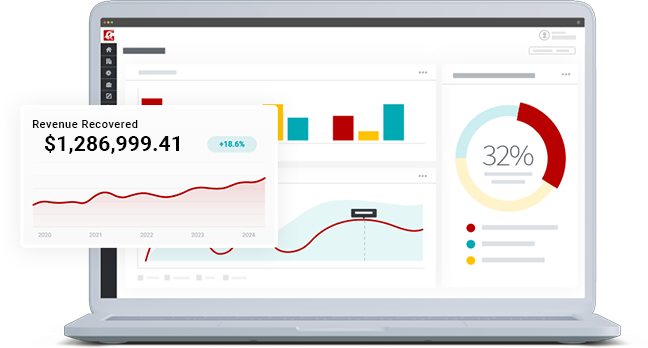
How to Report Fake Google Reviews
You can use Google’s Review Management Tool to report fake reviews, check the status of a pending report, or to appeal a review that got rejected by Google.
If you believe that a fake review violates Google’s content guidelines, you can follow these steps to report the review:
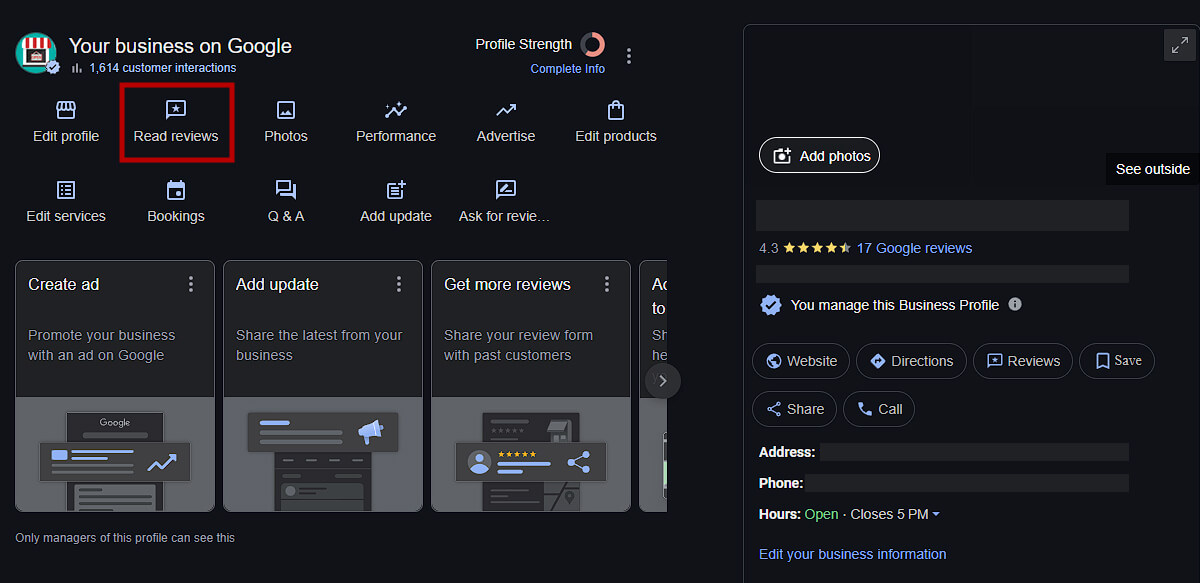
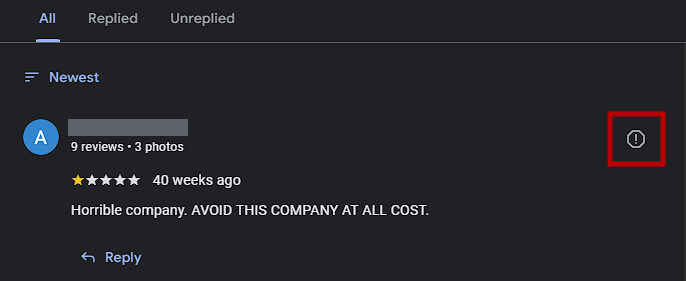
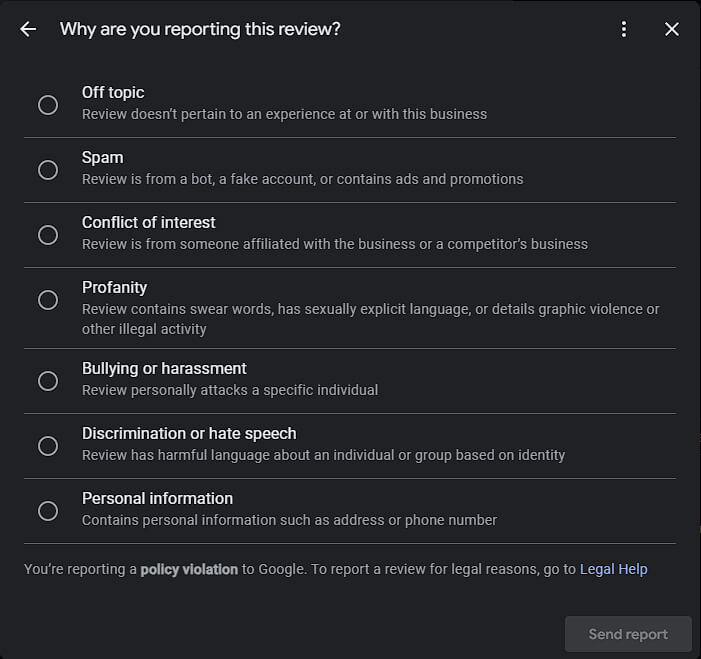
Already submitted your report, but want to check the status of a flagged review? Follow these steps:

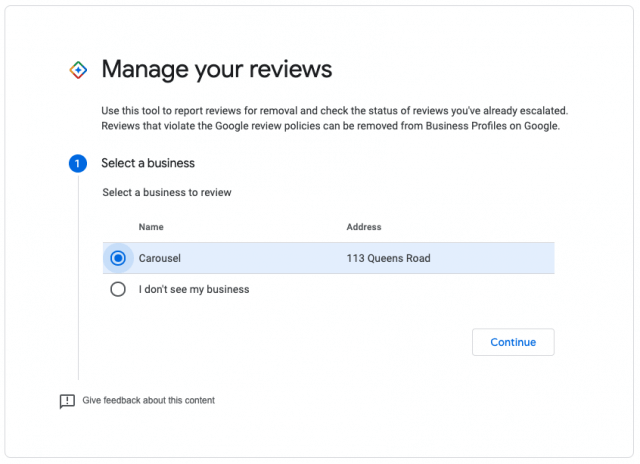
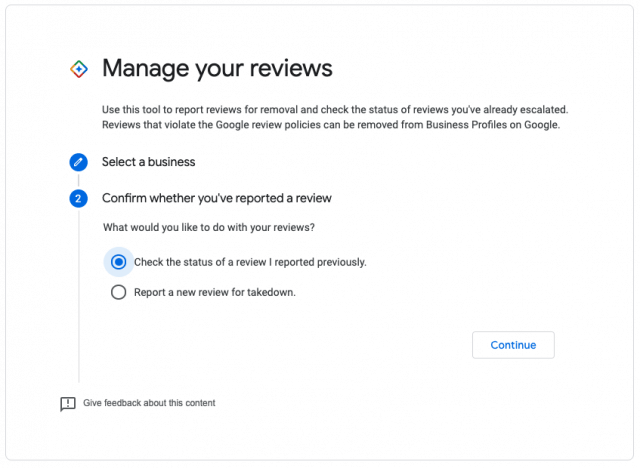
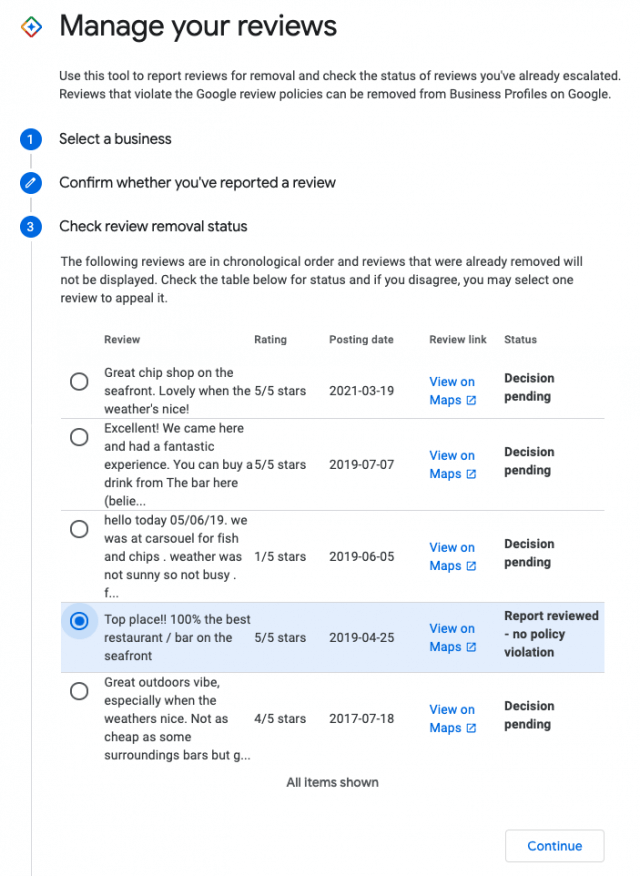
Let’s say your report got rejected. If you feel strongly that the review is fake, you can submit a one-time appeal:
#1 | In the Review Management Tool, click on “Check the status of a review I reported previously and appeals options”
#2 | At the bottom of the page, select up to 10 reviews to appeal, then click “Appeal eligible reviews”
#3 | Click “Continue”, then “Submit an appeal”
#4 | Fill out the appeal form in the new tab that appears.
You will receive an email informing you of the decision. If your appeal is accepted, the review will be removed. If your appeal is pending, you’ll see a status that reads Escalated - check your email for updates in the Review Management Tool.
How to Get Fake Google Reviews Removed
The only way to get fake Google reviews removed is to forward them to Google via the Review Management Tool.
We should note that not all fake reviews that are submitted for removal will be removed once flagged. And, that you only have one opportunity to appeal a review removal that was previously denied, so you’ll need to give it your best shot.
As part of your appeal, you’ll have the opportunity to explain which Google policy the fake review violates. You’ll also have the chance to provide supporting evidence to justify your claims. Responding promptly and professionally during the appeal process can make or break your case.
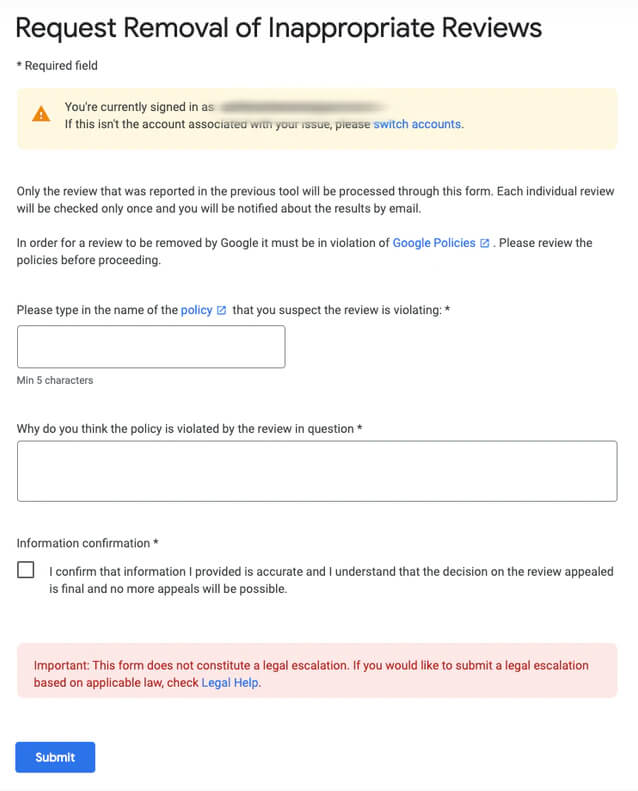
Next Steps: Is Legal Action an Option?
If you encounter fake reviews made by real people, you may be able to take legal action against those reviewers.
Obviously, this is an expensive, time consuming, and cumbersome process, so you should only retain a law firm to combat fake reviews as a last resort. That said, if you are being harmed by one or more identifiable bad actors in a systematic and pervasive manner, you may be able to recover damages — or at least have the review retracted — with the help of an attorney.
It’s no coincidence that the appeal process closely parallels chargeback representment. The tactics for succeeding at both are similar.
Providing objective, compelling, and relevant evidence in a timely manner in a way that unambiguously challenges the legitimacy of the review can go a long way in helping you win your appeal. Supplementing your appeal with a succinct letter that summarizes the evidence submitted can help you present an even stronger case for removal.
Preventative Measures: Tips to Prevent Fake Google Reviews
Like combating chargebacks, the best way to minimize the harm from fake Google reviews is to prevent them from occurring in the first place. There are several strategies you can try that can help you improve your odds here:
Implement Robust Review Management Policies
The best way to spot fake reviews is to closely scrutinize all customer testimonials. Doing so can help you quickly identify, report, and remove fraudulent reviews before they turn away a large number of prospective customers and do significant harm to your business.
Encourage Genuine Customer Feedback
One way to combat fake reviews is simply to outnumber them with real ones. Google’s terms of services allows you to incentivize customers to leave reviews, as long as you ask for honest feedback.
In addition to text, ask customers to leave photos and videos. Multimedia reviews that incorporate specific feedback are more helpful and likely to be interpreted as authentic by prospective customers.
Monitor & Respond to Reviews Effectively
Best practice dictates that you should respond to all genuine reviews using in a helpful, timely, and sincere manner. When customers leave positive reviews, show appreciation by thanking them in your brand voice, and highlighting aspects of their review to show that you took the time to read it.
When customers offer negative feedback, respond in a professional and objective manner. Take the time to apologize for falling short of expectations, and encourage them to contact you directly so that you can make it right.
Leverage Tech Advancements to Detect Fraudulent Reviews
Tools that use machine learning techniques like natural language processing (NLP) or natural language understanding (NLU) can help you parse and interpret reviews at scale in real-time. NLP and NLU tools can help you identify potentially fake reviews based on their content or tone, and may be able to forward suspicious reviews for manual review.
Foster Collaborative Relationship With Tech Platforms Like Google
You want Google to give you the benefit of the doubt when it comes to fake reviews. This means that your reputation with the internet giant matters: you want to be perceived as an honest, proactive, and trustworthy merchant.
No amount of good behavior on your end can guarantee that you’ll have fake reviews removed without a hitch. But, aggressive or dishonest behavior on your end almost certainly guarantees worse outcomes.
Need Help Fighting Fraud?
Fraud, whether in the form of fake reviews or invalid chargebacks, can harm your reputation and put a dent in your cash flow. Fighting fraud, however, is a high-stakes process that requires you to respond within a short timeframe and present a substantial amount of compelling evidence — all while getting it right the first time.
At Chargebacks911®, our dual-layered chargeback prevention and representment solutions can help you preserve revenue and keep fraud at bay. Reach out to us for a no-obligation ROI analysis today.
FAQs
How to fight fake Google reviews?
You can fight fake reviews by reporting them through the Review Management Tool, which is accessible via your Google Business profile. Once you log in, a menu tab will appear. Click Reviews, click on the reviews you want to report, and select Flag as Inappropriate.
Can you trace the IP address of a Google review?
No. As a business, you cannot trace the IP address of the profile that left a Google review, even if the user didn’t use a VPNs or proxy server to mask their location.
Is Google cracking down on fake reviews?
Yes, Google is cracking down on fake reviews. The search engine is agreeing to comply with new FTC rules by working to pinpoint and delete fake reviews that may affect businesses negatively.
How do I identify fake reviews?
To identify fake reviews, look out for unverified accounts and generic usernames. Reviews that do not mention the product or service offered or reviews that use overly enthusiastic language are also potential red flags.
Can you sue someone for a false Google review?
Yes, you can potentially pursue a defamation lawsuit against someone for a false Google review, so long as you can prove that you suffered damages as a result of their testimonial.
How do I delete bad reviews on Google?
You cannot delete bad reviews on Google. However, if you flag the review as inappropriate, Google will review your claim and remove the review if it violates its policies.



